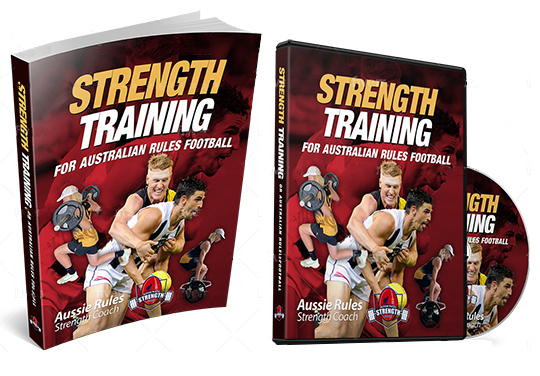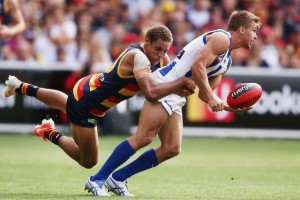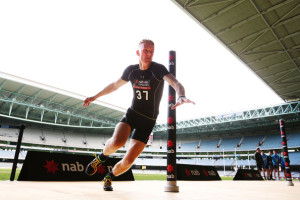Footy Strength
Once you start actually strength training to be a better footballer, rather than strength training the same as everyone else does, you will ask
Why aren’t these training principles commonly known and commonly performed by guys playing footy?
Why are there so many mistakes still being made with ineffective training programs? I see the same mistakes being made over and over again each day by junior and amateur/country level footballers (and sadly even guys playing at even higher levels) aiming to improve their performance on the field but going about it in all the wrong ways.
The most common mistakes;
Mistake #1 – Training like a bodybuilder rather than like a footballer
 There is a huge difference between training for the 2. Most young guys at the gym can’t think past the mirror, and the attitude that bigger is better. Whilst a certain amount of size is certainly good for a physical sport like footy, too much size is often detrimental, as your cardiovascular system will have to work even harder than previously, simply just to maintain the level you were at previously. Not only that, but even a slight gain in size is detrimental if you aren’t gaining at least a proportional improvement in functional strength. Just because you are putting on size doesn’t mean that you are improving your performance, and in most peoples cases, they aren’t improving at all.
There is a huge difference between training for the 2. Most young guys at the gym can’t think past the mirror, and the attitude that bigger is better. Whilst a certain amount of size is certainly good for a physical sport like footy, too much size is often detrimental, as your cardiovascular system will have to work even harder than previously, simply just to maintain the level you were at previously. Not only that, but even a slight gain in size is detrimental if you aren’t gaining at least a proportional improvement in functional strength. Just because you are putting on size doesn’t mean that you are improving your performance, and in most peoples cases, they aren’t improving at all.
Mistake #2 – Training primarily in 1 plane of movement
Football is played in a 3 dimensional environment, where our bodies are challenged in 3 planes of movement (sagittal, frontal and transverse.) So it would make sense to train our bodies in all 3 planes of movement, yet if you look at the strength training programs out there, about 90% of exercises performed are in the sagittal plane. Interestingly, about 85% of soft tissue and joint injuries that occur in football occur in the frontal and transverse planes…an almost completely inverse relationship. Very interesting to say the least! So squats and deadlifts for example are 2 fantastic compound exercises, and are the base foundation of most ‘functional’ sports training programs out there now, however, they are both sagittal plane exercises. Hopefully it is obvious that more work is required in the frontal and transverse plane.
Mistake #3 – Sticking to the same sets and reps schemes for each exercise –ALL YEAR ROUND
3 sets of 10 of this, 3-4 sets of 10 of that. 1 minute rest between each, and repeat. But why 10 reps? And why 3 sets? The short answer is probably ‘because that’s what everyone else does.’ In some instances, this sets and reps scheme is good. However, it requires some changing up, depending on the exercise, the goal of the exercise as well as the timing of the exercise. Sets, reps, rest time and intensity are all interdependent variables that are rarely considered when training, however, a little more understanding of these is required when it comes to getting the most from your football strength training program.
Furthermore, it is well known at the elite level of sport (and has been for decades) that the way you train (what types of exercises, how much weight, how many sets and reps, how much rest time, etc) must be changed at different times over the course of the season, depending on what stage of the year it is. If not, not only will you stop making gains in performance, but you will actually go backwards!
Mistake # 4- Too much isolation training
This is ano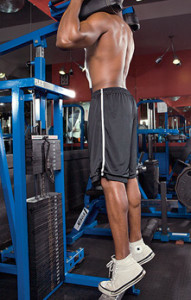 ther bodybuilding virus that has infected the training programs of many athletes. In short, if you are doing bicep curls and tricep extensions and shoulder abductions and calf raises, you aren’t improving your physical performance for football at all. You are simply isolating a muscle in a way that it is never actually isolated in football, and as a result, gaining nothing. When you are training to improve your performance and functional capacity, you must train your nervous system not just your muscles. Your nervous system controls your muscles and every movement you perform, and if your nervous system isn’t being trained and improved, neither is your performance. Isolation training does nothing for your nervous system or your performance. Don’t get me wrong, isolation training has a place (specifically with the initial stages of rehab or if there is a real specific focus that you require to correct a deficiency.) However, if you are an athlete with only limited time to dedicate to strength training (say 2- 3 sessions) then you must make everyone a real efficient one with ‘bang for your buck’ exercises. Isolation exercises certainly don’t fit this bill.
ther bodybuilding virus that has infected the training programs of many athletes. In short, if you are doing bicep curls and tricep extensions and shoulder abductions and calf raises, you aren’t improving your physical performance for football at all. You are simply isolating a muscle in a way that it is never actually isolated in football, and as a result, gaining nothing. When you are training to improve your performance and functional capacity, you must train your nervous system not just your muscles. Your nervous system controls your muscles and every movement you perform, and if your nervous system isn’t being trained and improved, neither is your performance. Isolation training does nothing for your nervous system or your performance. Don’t get me wrong, isolation training has a place (specifically with the initial stages of rehab or if there is a real specific focus that you require to correct a deficiency.) However, if you are an athlete with only limited time to dedicate to strength training (say 2- 3 sessions) then you must make everyone a real efficient one with ‘bang for your buck’ exercises. Isolation exercises certainly don’t fit this bill.
Mistake #5 - Too much machine training
Just a quick definition of a machine; I am speaking only of the pin loaded or plate loaded machine s here, which operate on a fixed axis, meaning that all you need to do is pull or push or press and the machine follows a fixed path. Cable pulley systems do not count as machines in this definition as you still have complete freedom of movement, and are required to control the movement yourself, and are used extensively on this program. A functional strength training program for footy will not include any machine exercises. Or if it does, they will be minimal, and only considered once the real exercises have been completed for the session.
s here, which operate on a fixed axis, meaning that all you need to do is pull or push or press and the machine follows a fixed path. Cable pulley systems do not count as machines in this definition as you still have complete freedom of movement, and are required to control the movement yourself, and are used extensively on this program. A functional strength training program for footy will not include any machine exercises. Or if it does, they will be minimal, and only considered once the real exercises have been completed for the session.
Football requires a great deal of core control and joint stability when perfor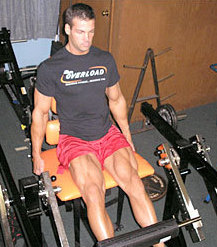 ming anyone of a wide range of movements; accelerating, decelerating, kicking, changing direction, jumping, marking, tackling or absorbing contact just to name a few. These are tremendously challenging tasks, and is it any wonder so many injuries to shoulders and knees and hips arise when we are forced to perform these tasks yet don’t condition our bodies for them? A certain amount of ‘prehab’ (‘prehabilitation’ – conditioning appropriately before any injury arises) is a necessity, and should be a focus of every sport strength training program, not just football. In short, any exercise done on a machine does not provide for this, as these exercises do not require any work from your core muscles or joint stabilisers, as the machine is on a fixed axis, meaning the machine determines the path of your movement, regardless of if you have any control of it or not.
ming anyone of a wide range of movements; accelerating, decelerating, kicking, changing direction, jumping, marking, tackling or absorbing contact just to name a few. These are tremendously challenging tasks, and is it any wonder so many injuries to shoulders and knees and hips arise when we are forced to perform these tasks yet don’t condition our bodies for them? A certain amount of ‘prehab’ (‘prehabilitation’ – conditioning appropriately before any injury arises) is a necessity, and should be a focus of every sport strength training program, not just football. In short, any exercise done on a machine does not provide for this, as these exercises do not require any work from your core muscles or joint stabilisers, as the machine is on a fixed axis, meaning the machine determines the path of your movement, regardless of if you have any control of it or not.
Mistake #6 - Not enough focus on muscle balance, mobilisation and recovery
Tight muscles and muscle imbalances leading to poor posture around certain joints or over the whole body (as an imbalance in one place will normally lead to imbalances elsewhere) will lead to pains and eventually injury. It may seem obvious that a certain degree of flexibility is required to play football effectively and with minimal soft tissue and joint injuries, however you can also exacerbate existing muscle imbalances with a poorly rounded strength training program. In fact, a great majority of the guys you see around you at the gym who on the outside have really impressive looking physiques, actually have bad muscle imbalances as a result of poor training programs. In other words, they may look good, but their balance and functional capacity for movement isn’t good. And in reality, it probably doesn’t really matter if all you are training for is how you look in the mirror or how well you will pose on stage at your next bodybuilding event, but as soon as you start competing in a sport requiring some functional and explosive movement, particularly the most dynamic sport on the planet in Australian football, you are placing yourself in a position where injury is inevitable, if not in the short term than at some stage later.
It is important to realise that poor muscle balance and whole body posture will not just greatly increase the incidence of injury, but also reduce your movement efficiency and therefore by definition, your performance. This is because, while there are imbalances, you have to work even harder to perform the same task than you would if correct balance existed.
Mistake #7 – Not enough lower body strength training
If 50% of your strength training isn’t spent on your lower body, you aren’t doing enough. No the running work you do doesn’t count! This mistake isn’t as commonly known as you may think it is, and you may not realise just how widespread this is. We all know that guys love doing their biceps and chest and triceps in the gym, but then hate working on their lower body, mainly because its hard, but also because the benefits aren’t as easily visible in the mirror. That is, when you do a bicep curl or work on your arms, you can see the muscle bulging in your arm, and changes in size over time are far more quickly noticed, which isn’t usually the case with legs. At the end of the day, these things are irrelevant, because you want to be a better conditioned footballer, not a bodybuilder.
Mistake #8 – Being too anterior chain focused
The anterior chain is a fancy way of saying the muscles on the front half of your body….you know the ones, the ones that are most easily visible in the mirror. Chest and biceps and 6-pack abs in short, are the most commonly worked muscles, and then when time is found for leg work, it is normally the quads copping most of the work. Meanwhile the entire posterior chain goes under-trained, and as a result, muscle imbalances develop, and over time, as more and more training and playing occurs with such imbalances, injury results. 2 great examples in footy; hamstring injuries as a result of under training the hamstring and glutes, and only focusing on quads, and shoulder injuries (particularly dislocations and subluxations) as a result of upper body muscle imbalance and the resulting poor rounded posture (shoulders rounded and chest depressed.) In short, we must not forget the back half of our body if we want to improve performance, but also reduce injury.
The most common mistakes
-Training like a bodybuilder rather than like a footballer
-Training primarily in 1 plane of movement
-Sticking to the same sets and reps schemes for each exercise all year round
-Too much isolation training
-Too much machine training
-Not enough focus on muscle balance, mobilisation and recovery
-Not enough lower body strength training
-Being too anterior chain focused
So why are these mistakes still so widespread?
The simple answer is that the knowledge and information just hasn’t been shared, and to a lesser extent, it probably isn’t understood properly by many people in the first place.
We believe that the fitness industry at large is greatly to blame. The fact is that the fitness industry itself has been driven greatly by the desires of bodybuilders and the desire for looks and aesthetics rather than function.
The wheel is slowly turning and more inroads are being made to correct the fallacy of athletes training with bodybuilder techniques, but once something is deeply ingrained its hard to get rid of.
Furthermore, whilst there is more of a push from professionals espousing the benefits of ‘functional’ training for football and other sports, there is still a lack of understanding on just what ‘functional’ means in its application to football.
Often times what is out there being pushed as a football strength training program, is simply a standard bodybuilding - or slightly better - strength training program re-packaged as a ‘functional football training’ program.
What may be termed as functional for one sport or one task or goal won’t necessarily be of value to Australian Football
Plenty of work has been done at the elite level to refine the practices involved in strength and conditioning, however, for whatever reason, the information doesn’t seem to have filtered down to the grassroots level. However the life and reality that exists at the elite level is so vastly different to that that exists for the other levels of the game and its participants. Not only in terms of what the game looks like, but also the realities of how much time you can dedicate to your strength training for football.
If you are reading this, you likely;
-Work full time
-Are a student
-Play state level or amateur league
-Are a junior footballer
-Can only dedicate 2 sessions a week to strength training (or 3 if it is your off-season/pre-season)
As a result, a lot of the information that may start to filter down from the elite level in terms of their programs and methodologies will be unusable to you or others who cant dedicate 30 hours a week to training and recovery anyway.
However what isn’t unusable are the principles of functional movement for Australian football.
There is a great lack of readily available information out there for comprehensive functional strength training for Australian Football. Other sports have a lot more information readily available due to their more global nature, and perhaps simpler skill sets (although a lot of this information is still of a limited quality.) However, it is important not to fall into the trap of expecting a strength and conditioning program aimed at basketballers, to be of benefit to you as a ruckman in football for example.
So despite the fact that this sort of information should be common knowledge, and be the baseline of every strength training program for football, the fact is that this information remains largely hidden. But with this program now at your disposal, you are ahead of the pack with your knowledge, and its just a matter or applying it.
So why are the majority of junior and amateur level footballers still training like bodybuilders?
Being a bodybuilder is no where near as tough as being a good footballer. Or more specifically, the training required to be a bodybuilder is nothing compared to the type of strength training required to be a better football.
This is why there are so many people out there who are bodybuilders now. It doesn’t require much in terms of your training program. It can be very basic and generic, and largely dependent on your diet. Basically, it doesn’t matter what exercises you are doing, as long as you blast the hell out of the major muscle groups and eat a very strict diet you will see the results sooner rather than later.
To improve your v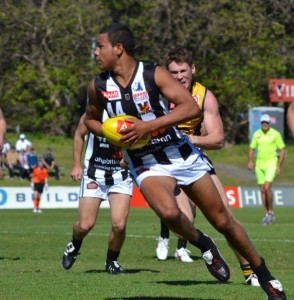 ertical leap, or your first 10 meters in a sprint, or your ability to jump, land change directions and tackle on the other hand, requires a lot of work, and more importantly a lot of the correct type of work, before you notice any improvements. Because after all, only your performance in matches or competitive match simulations will tell you whether you are improving. Simply looking in the mirror and having bigger quads and biceps won’t give much indication (although it may look good.)
ertical leap, or your first 10 meters in a sprint, or your ability to jump, land change directions and tackle on the other hand, requires a lot of work, and more importantly a lot of the correct type of work, before you notice any improvements. Because after all, only your performance in matches or competitive match simulations will tell you whether you are improving. Simply looking in the mirror and having bigger quads and biceps won’t give much indication (although it may look good.)
The fact that there is also a lot of money out there to be made from the bodybuilding industry doesn’t help with these poor training practices being so widespread. The fact that it is so easy to get into bodybuilding (in terms of what is required of you physically) means that the market for anyone willing to cater to them, is huge. Be it easy-to-use pin loaded machines, weight belts, powders, pre-workouts, muscle magazines, etc, it is a booming market financially, and there are plenty of dollars to be made. On the other hand, the majority of people making money from the improvement in a footballers athletic ability, are those that are employed at the highest level of the game. As a result, there is very little potential for quick an easy money to be made from this, and very little potential for gimmicky products.
It sounds like we are beating up on bodybuilding, but we aren't. We have a great deal of respect for the dedication that it requires to have every day (particularly with diet habits.) However, we get fed up seeing these training practices hijack the training programs of footballers looking to improve their functional capacity, and become better footballers.
So what physical improvements does being a better footballer require?
- Higher vertical leap
- Explosive first 5-10 step sprint
- Decelerating quickly and efficiently
- Changing directions more effectively than your opponent
- Pushing off an opponent with 1 arm or 2, whilst sometimes being off balance or only on 1 leg
- Improved landing power (from a jump)
- Tackling an opponent, and for repeated efforts
- Evading a tackle
- Stabilising every joint in your body when receiving a bump or tackle
- Or any number of variances or combinations of the above
- As well as the ability to be able to do these things over and over
Be honest: do you think your current strength training program is providing the necessary challenge on your body to actually be able to improve at any of these? Or are you still purely focusing on the size of your shoulders, chest and biceps?
Training the nervous system for physical performance is vastly different to training muscles to look bigger and better. If you think that having bigger muscles automatically means that they are now stronger and equipped for the physical nature of football, think again!
Whilst a bigger muscle and therefore a bigger cross section of muscle fibres has the potential to be stronger, this will only be the case if the training techniques have had the appropriate effect on the nervous system. After all, muscles are controlled by the nervous system, and despite the fact that people tend to think mostly in terms of muscles when it com es to strength training, all gains that you make in performance are actually improvements in the performance of your nervous system and the nerves that feed your muscles for movement.
es to strength training, all gains that you make in performance are actually improvements in the performance of your nervous system and the nerves that feed your muscles for movement.
That’s right, in terms of functional strength training for football, your muscles per se, are almost irrelevant. Yes you will develop some muscle mass performing a functional strength training program, but we are far more focused on the improvements made by your nervous system and the movement and strength that this builds. Remember, training to be a better footballer requires training to move better (in a variety of ways.) And movement is controlled by your nervous system, not your muscles.
Football is about movement, not muscles, so lets focus our strength training accordingly
Functional Strength Training for Australian Rules Football is your definitive guide to correcting the mistakes of the past (and present) and performing a strength training program tailored to physical improvement specifically for football

Sam
'I love it because it is specific to aussie rules, which you don't get anywhere else! I got it because I believed it would help my footy and I believe it has by making me stronger around the contest and in 1 on 1's. The aim I had was to not put on more weight or muscle but to have more power and strength over the ball and I definitely have now.'

Adam
'I have an undergraduate degree in exercise and sport science so I understand the fundamentals of a program. However I am very time poor so this program being planned out for 12 months with excellent explanation to support was fantastic. The videos are a bonus!'

Rhys
'In the past I was a person who would just do the stock standard bench press, shoulder press, etc and try to increase the weight as I progressed, but after reading the footy strength and power programs, I now understand that if you are doing this you are more disadvantaged because of your size and weight and this can lead to a decreased input on the field.
The things I was doing in the gym weren't 'footy focused' and I was getting a little too big and slow and have had a lot of injuries in the past 5 years. I wanted something to help me strengthen these 'injury areas' as well as improve my football as an individual off the field, which I feel I have.'
What Functional Strength Training for Australian Rules Football ISNT
- A generic program re-packaged as a football strength training program (geez there are a lot of these getting around)
- Another program based around bodybuilding principles
- An unrealistic program requiring you to dedicate 4-5 strength sessions a week like full time players
- A supplements-crazy plan
- Designed by a textbook geek who has no understanding for the true demands of the most dynamic sport in the world
What Functional Strength Training for Australian Rules Football IS
- A truly Australian rules specific strength training program
- Time efficient, allowing for you to train between 2-3 times per week, depending on your ability, time availability, and time of the season
- Truly functional for footy– all 3 planes of motion, full body, inner unit core and stability, maintaining a focus on postural balance, to name a few (we cover and explain over 20 principles of functionality too)
- A periodised plan culminating in power development
- Comprehensive yet easy to follow and understand
- A learning tool as much as something to follow – you will understand completely why you are doing what you are, and will always be able to make the best choices for yourself and your footy going forward
- Based on the principles used at the elite levels of sport
- Adaptable - Designed for everyone from the teenage footballer picking up his first weight, to experienced state level player looking for a 2% improvement in their work capacity
So what are the benefits to you?
- Greatly reduce the risk of soft tissue injury
- Stronger body at contests – with an equally proportionate amount of usable strength
- Learn and perform exercises (properly) that will actually benefit your physical demands in footy
- Put into place correct programming and varying of sets and reps and weight for all the key exercises, over the course of a whole year
- Entire first 12 months of strength training program laid out, as well as how to use this exact template for the following seasons with progressions, depending on how quickly you progress
- Actually get ahead of the pack (while everyone else is still training incorrectly)
- Achieve far more in less time
- Look better at the same time – and you will perform as well as you look

Reynton
'I loved the blocked parts, separated into the pre-season and in-season, and then separated into anatomical adaption, hypertrophy, strength and power for pre-season and volume and strength for in-season. It felt like I was following a program that was very professional.
The explanations of the lifts was also really helpful - I knew how to do most of the lifts, but the explanations helped with little tweaks I could make to make more of a difference in increasing by strength.
I also downloaded the program for my own learning of how to design programs. I am currently studying sport science, with an aspiration to become a strength and conditioning coach, and so it is really helpful as a way to see how different programs can be effective.'

Lachlan
'I liked how the program introduced the topics with theory. The mention and description of the planes of movement were very helpful as I was not fully aware of them. I also found it intriguing how it explains to train movement patterns as opposed to just muscle groups in isolation.
I had hoped to add a little bit of size but a lot of strength without taking away from my running ability - and I found that I was able to do this by incorporating the footy specific exercises provided. From this book I have taken a more expansive knowledge of training specificity and how this can be applied to football.'

Ross
'Having completed my ASCA Level 1 S&C coaching course, I had aimed to supplement my technical knowledge with some additional resources, and I believe I have taken a bit away from the structure of the program. The program also allowed me to make a few tweaks to my program and I am really happy with the results.'
Don’t fall into the trap of just doing something because everyone else is doing it, nor believing that just because no one else is doing it, it must be wrong.
Don’t forget, most people around you at the gym aren’t there for the same reasons as you. You want to improve your performance as a footballer, they want to look better in the mirror. That doesn’t mean that you wont have both, its just that you will have to train a lot smarter and more specifically to achieve you goal.
So what EXACTLY does Functional Strength Training for Australian Rules Football include?
- In depth discussion of what exactly functional means in terms of Australian Rules – made up largely of discussion points almost NEVER mentioned
- A thorough needs analysis for Aussie Rules – with more specific and hardly discussed variables (not just the usual ‘run faster’ ‘kick further’ ‘tackle’ needs)
- Detailed outline and description (including picture and video demonstrations) of the key exercises to build every strength training for footy program around
- More than 30 detailed exercises, including descriptions and all important directions of how they should be programmed
- Discussion and outline of functional core work for Aussie Rules Footy
- How to scale certain exercises, depending on your level of experience and current ability with strength training
- Direction going forward for how to progress certain exercises, depending on your rate of improvement and your current ability
- In-depth discussion on the importance of periodisation, and how exactly this looks in terms of a footy season – as well as several footy seasons
- Not only that – we have outlined a year long periodised training plan, with direction and detail right down to how many weeks certain exercises and periods should be performed
Including detailed discussion on what functional means in terms of football
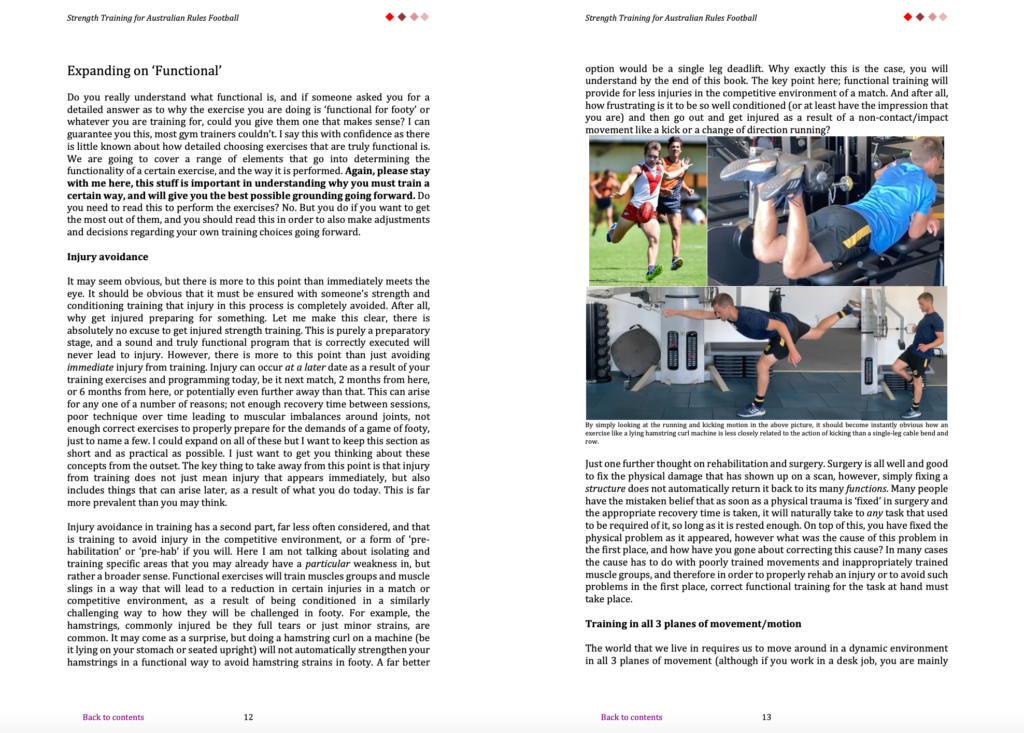
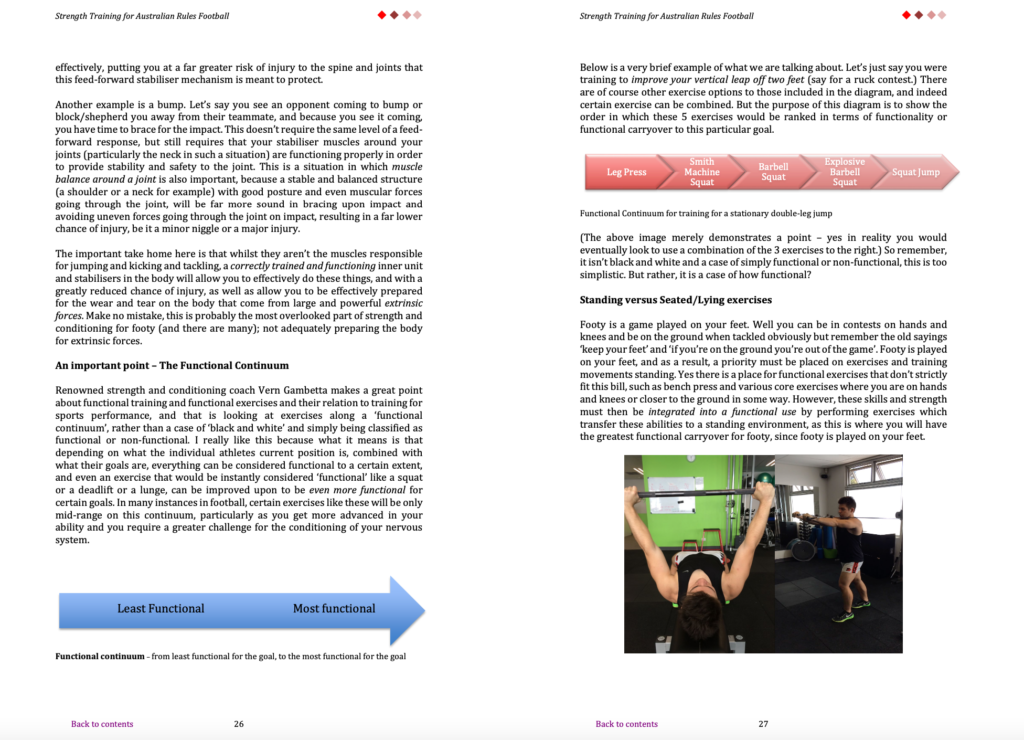
And building on this with what exactly this means in terms of your own training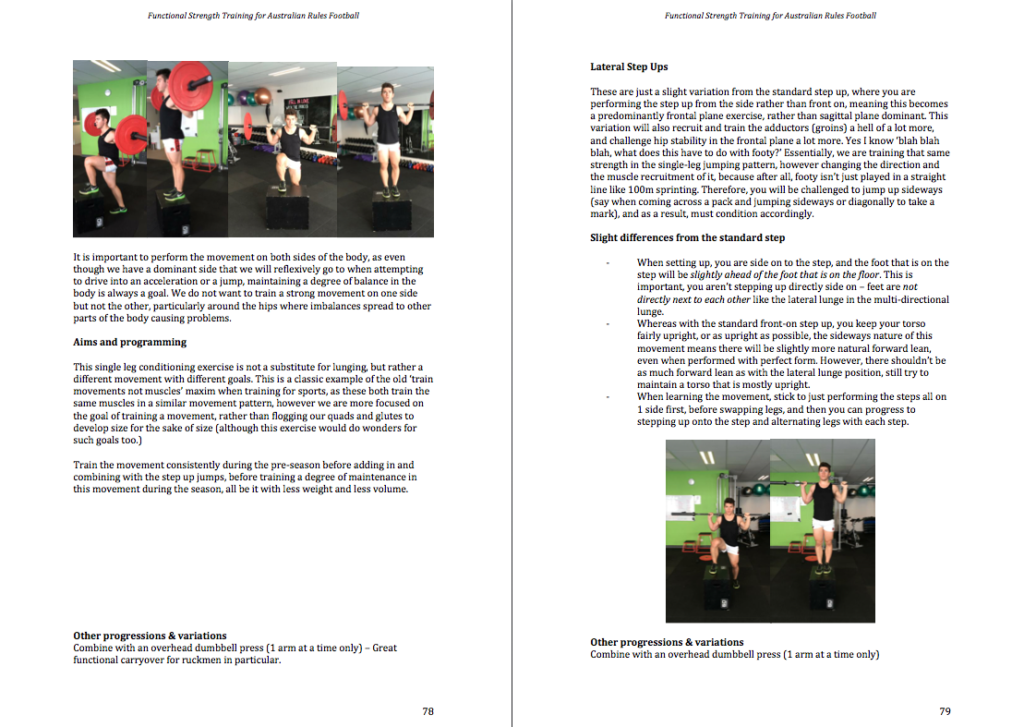

Exercise catalogue including detailed technique and programming instructions, as well as video demonstrations
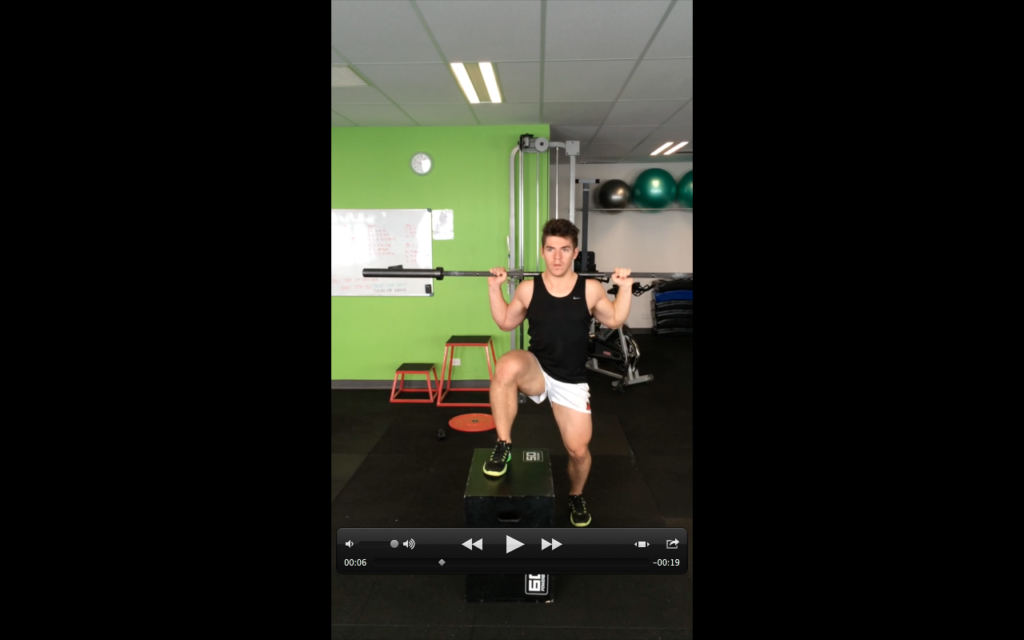
All-important periodised programming around a football season, and directions for flexibility & adaptability of layout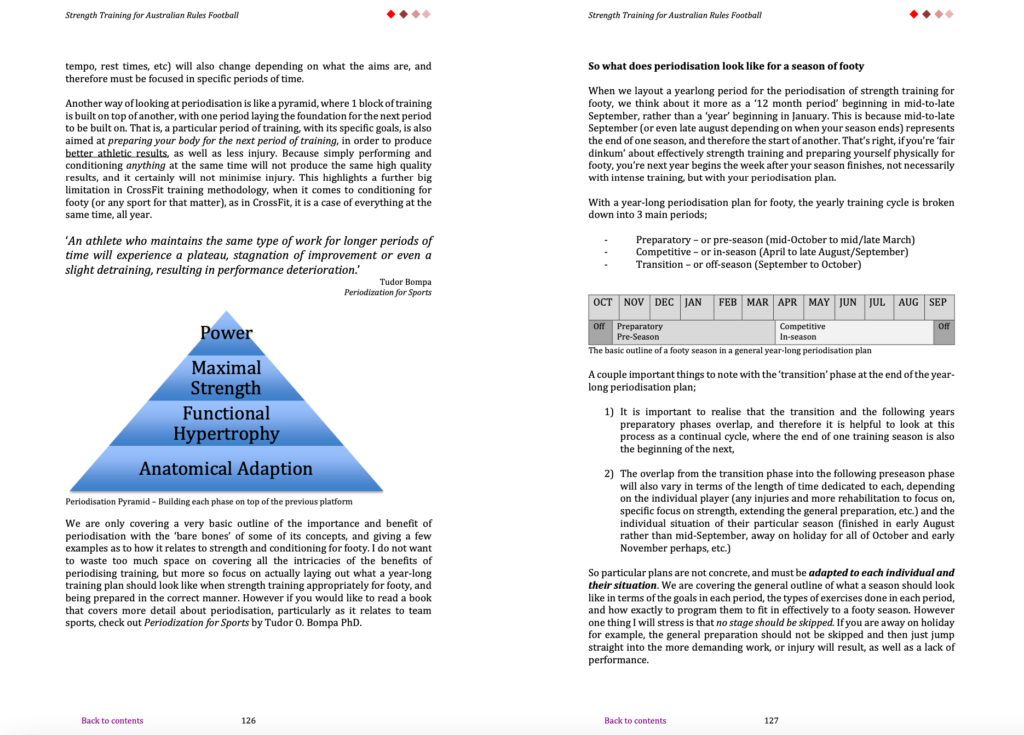

Discussion on running, agility, warm-ups, stretching, power development and more.......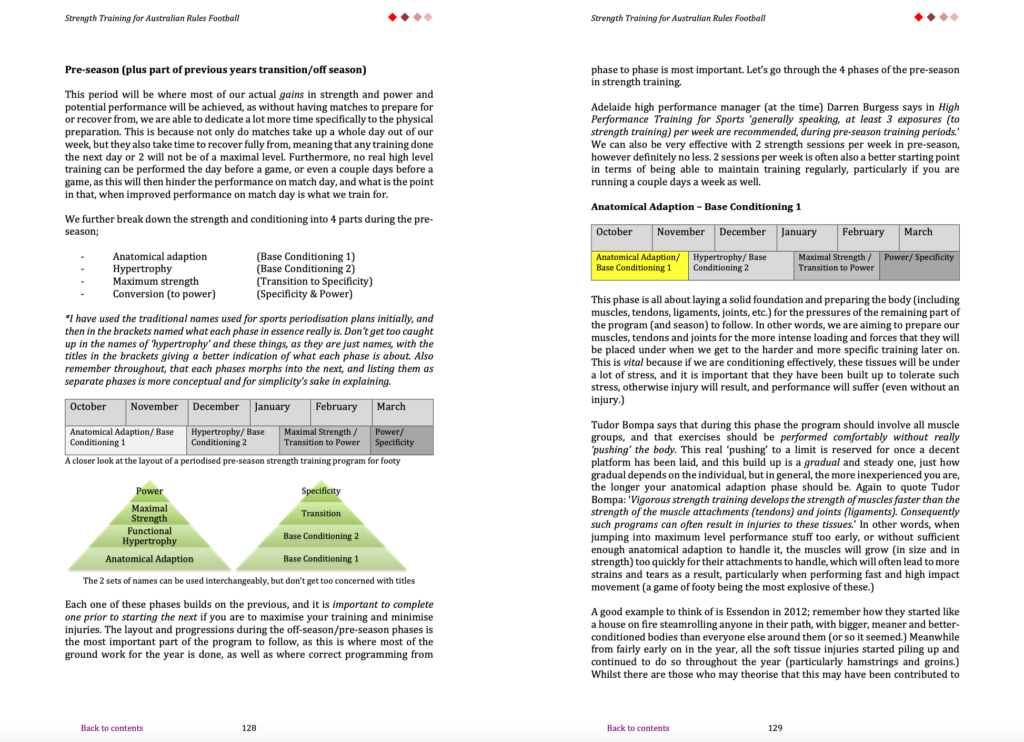
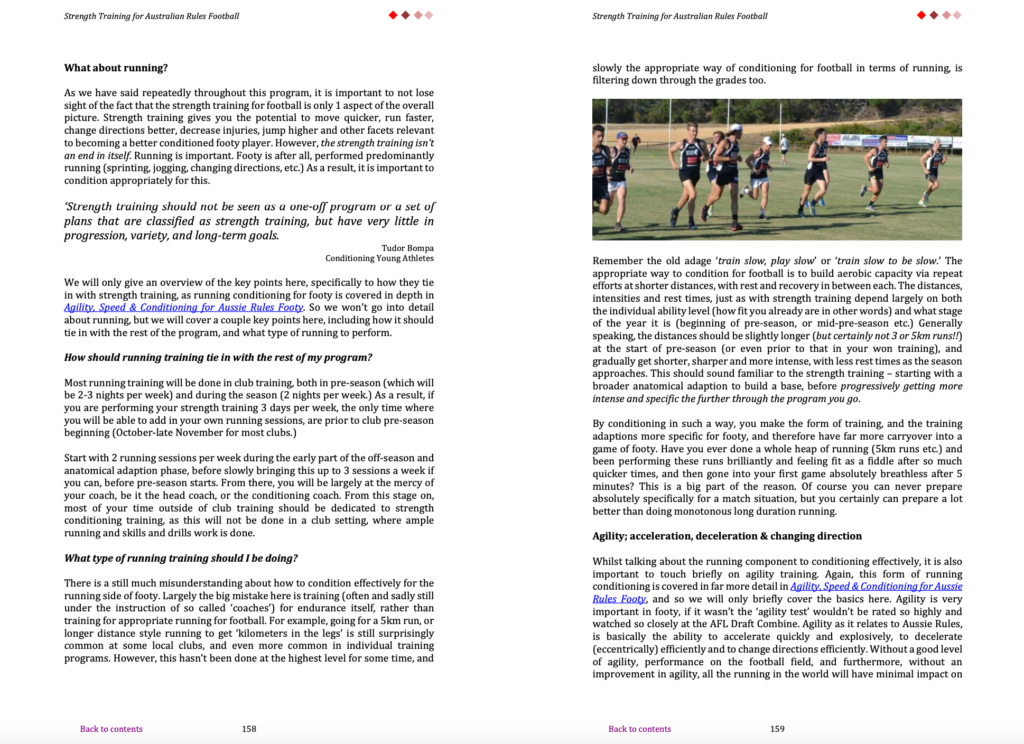
By the end of simply reading this program, let alone performing it, not only will you have the blueprint to greatly improve your performance, but you will easily be able to identify useless exercises being performed around you by guys with the same goals as you, as well as be able to explain in simple detail what ‘functional for footy’ exactly means. You will also have absolutely no problem being able to explain why a leg press is useless for improving vertical leap, and why just performing a heavier bench press will not instantly mean that you are better equipped to push off an opponent, but rather only give you more potential too do this, provided a couple more exercises and footy specific variables are added into your pushing program.
In addition to the strength training exercises and detailed periodised program, we also cover;
- Effective running conditioning – and how this ties together with the strength training program
- The importance of agility – and how to get it
- The essentials of the various forms of stretching for footy
- Functional warm up direction
- Discussing the Olympic lifts and their position in a footy conditioning program
- A detailed discussion on the pro’s and con’s of crossfit training (in terms of their relevance to football)
- A detailed resources list for the academically minded who would like to read even more in depth into the scientific principles covered

Reynton
'I found the checkout process to be very easy! Downloading the ebooks and videos was very easy.'

Lachlan
'The checkout process was very easy to follow!'

Ross
'I originally had a little issue with the checkout system, however it was quickly sorted with a follow-up email. No complaints at all from my end.'

Rhys
'I didn't originally get the initial book sent after checkout, but once I emailed it was fixed straight away and was sent straight away which was fantastic.'

Ben
'The checkout and download process was too easy, it was a breeze!'
Completely Updated & Reconstructed in 2023

